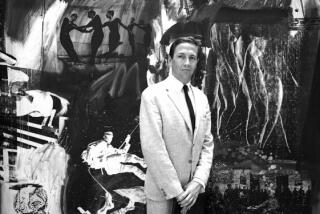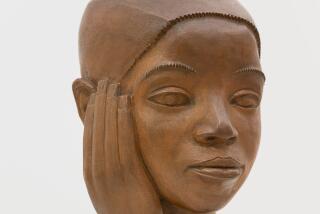The loopy, freewheeling life of a famously unknown artist
You don’t just learn how to draw a bunny in “How to Draw a Bunny,” the delightful, unabashedly celebratory documentary about the life and times of the late artist Ray Johnson, you learn a few other useful things as well. For instance: In the lost paradise of New York City during the 1950s, you could rent a cold-water flat for $28 a month. After rent, there wasn’t much money for food, but you could drown in free booze at parties while you grew thinner in the name of your muse. As painter James Rosenquist marvels, recalling these halcyon days of wine and gallery poses, “artists were extremely hungry.”
One of those hungry artists was Ray Johnson. A first-rate collagist and lifelong fringe dweller who became celebrated in rarefied circles as the “most famous unknown artist” in New York, Johnson enjoyed an almost paradigmatic modern-art trajectory. Born in Detroit in 1927, he attended the legendary Black Mountain College in North Carolina during the late 1940s. There he met the avant-garde dynamic duo of John Cage and Merce Cunningham and began a three-decade-long intimate relationship with Richard Lippold, a married artist with children. From this aesthete’s idyll, Johnson migrated to Manhattan, where over time he befriended the likes of Rosenquist, Christo, Chuck Close and Roy Lichtenstein, who all remember their less-renowned colleague in the film with affection, respect and degrees of amused bafflement.
Maybe it was the freewheeling times, maybe it was the company he kept (Cage was apparently a salutary influence), maybe it was part of his wiring, but Johnson didn’t limit himself to traditional studio art; he made art in the streets and even by way of the U.S. Postal Service. He drove collectors crazy by promising them “nothing”; says one still-amused dealer, “I stopped showing his work because I couldn’t get any.” Graced with a puckish, inventive sense of humor, the artist was a master of puns, word play and strategic silliness. It’s hard to know whether the wit and waggery were there from the start or whether they were born out of necessity. Poverty and anonymity can either crush an artist’s spirit or push it to new extremes, and Johnson may have used humor partly to take the edge off his own marginality
Having studied with Josef Albers at Black Mountain, Johnson moved away from Abstract Expressionism during the 1950s to become one of the following decade’s more quixotic purveyors of Pop Art. To that end, he stopped painting, destroyed his early work (it’s unclear whether the beautiful geometric studies shown in the film were among the casualties) and embraced collage, a format that allowed him to combine his fine-arts training and pop-cultural obsessions. In Johnson’s meticulous, carefully worked pieces, high art meets low amid witty cartoon squiggles and images looted from magazines and newspapers. Under the influence of Joseph Cornell, among others, he created art that embraced and finally transcended classification, one in which the legacy of Pablo Picasso collided head-on with the pop-iconic status of daughter Paloma, a recurrent figure in Johnson’s later work.
Part biographical portrait, part mystery story (Johnson’s suicide in 1995 left friends and colleagues baffled), “How to Draw a Bunny” is the first feature from the promising partnership of John Walter and Andrew Moore. As directed and edited by Walter, and sensitively shot by Moore, who did double-duty as producer, the film is a seamless model of form and content. (My only quibble is the poor quality of the digital video, which doesn’t do justice to Johnson’s work.) “Everyone had a story about Ray Johnson,” says the sheriff who investigated his death. What Walter and Moore reveal in “How to Draw a Bunny” is that many of those stories were as loopy and pleasurable as Johnson’s art, a living memorial to an artist who turned his very life -- including his friendships, his obscurity and even his death -- into fabulous art.
*
‘How to Draw a Bunny’
MPAA rating: Unrated
Times guidelines: Some adult themes
A Mr. Mudd presentation, released by Palm Pictures. Producer and cinematographer Andrew Moore. Director and editor John Walter. Music Max Roach. Additional music Thurston Moore. Running time: 1 hour, 30 minutes.
Exclusively at Laemmle’s Sunset 5, 8000 Sunset Blvd., West Hollywood (323) 848-3500.


